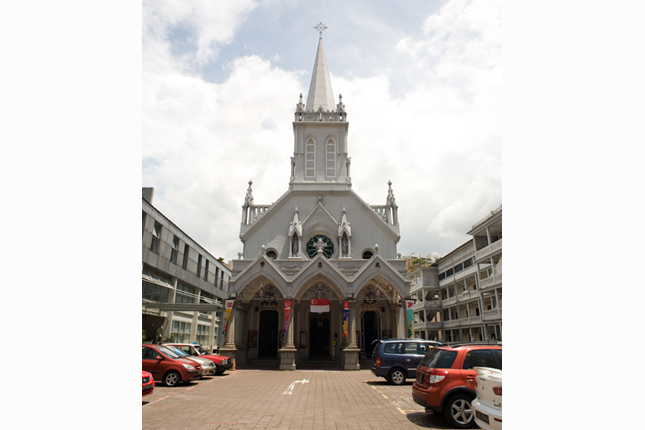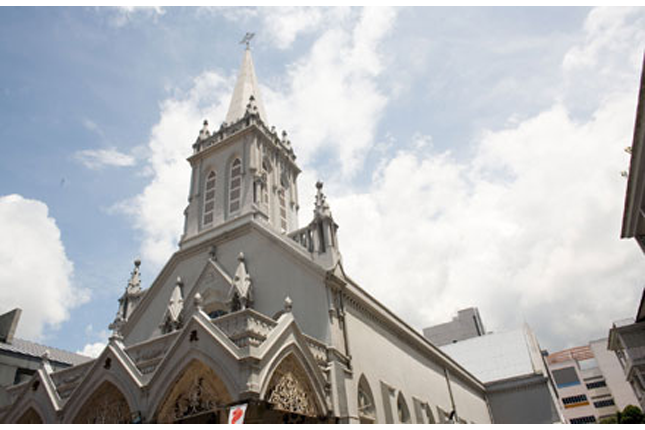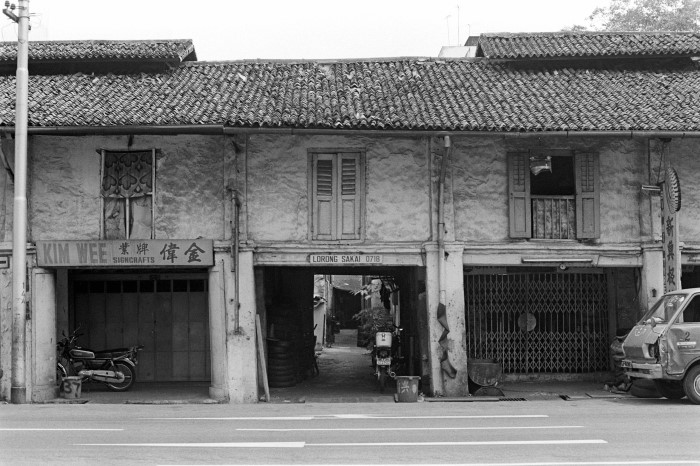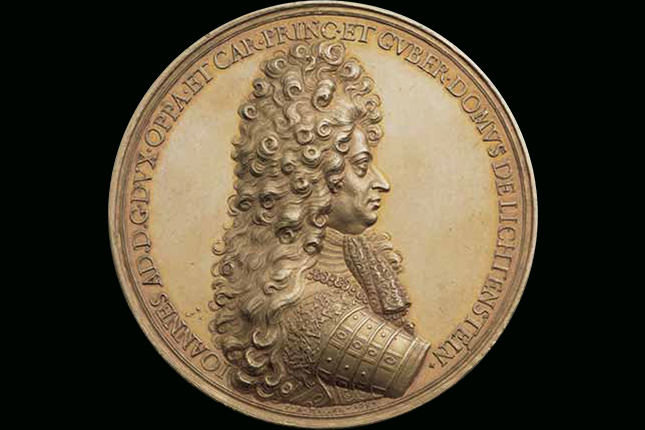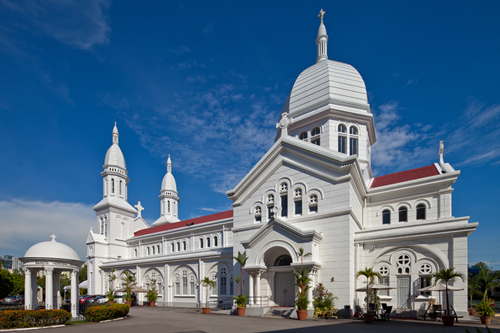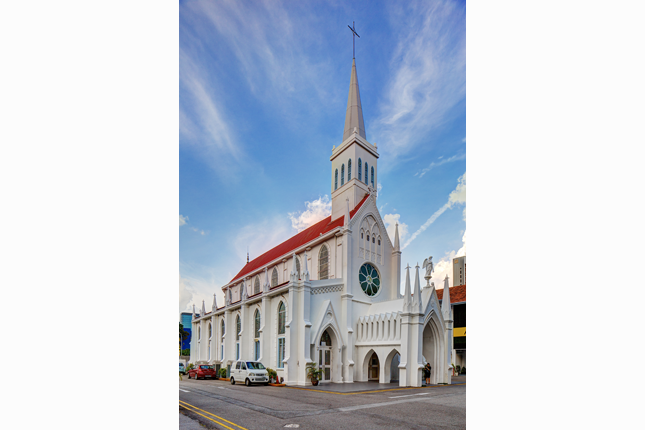The Church of Saints Peter and Paul is one of the oldest Catholic churches in Singapore that catered to a predominantly Chinese congregation. It is situated in the vicinity of the Cathedral of the Good Shepherd, Former Saint Joseph’s Institution, and Saint Joseph’s Church. Built more than a century ago, it stands today as a testimony to the spread of the Catholic faith and also to the contributions of Catholic missionaries to education in Singapore.
Early Years of Catholicism in Singapore
Prior to the construction of the Church of Saints Peter and Paul, the Chinese and Indian Catholic communities living in the town area attended Holy Mass at the Church of the Good Shepherd, where the majority of the congregation was European. In 1858, Reverend Father Pierre Paris, a priest from the Society of the Foreign Missions of Paris (MEP) who was proficient in several Chinese dialects and Tamil, was assigned to head the Chinese Mission and attend to the Tamil-speaking Catholics. Before this appointment, he had ministered to the Catholics in a small church in Hougang, which eventually became the Church of the Nativity of the Blessed Virgin Mary.
Churches for the Chinese and Tamil Catholics
With the rapidly growing Chinese and Tamil Catholic communities, the need to preach in their languages became more pressing. It was then decided that a new church was required to accommodate both the Chinese and Tamil Missions. Work on the church began in 1869 and was completed the following year. In 1883, Father Paris purchased and installed three bronze bells in the belfry. Unfortunately, he passed away on 28 May that same year before he could witness the blessing of the bells. He was buried in the central aisle of the church.
His successor, Reverend Father Ludovic J. Galmel, MEP, finished the work on the spire and built a presbytery to house the clergy. As Father Galmel spoke no Tamil, Reverend Father Joachim A. M. Meneuvrier, MEP, was appointed his assistant to take charge of the Tamil Catholics. Father Meneuvrier later founded what was nicknamed the Tamil Church – the Church of Our Lady of Lourdes to be the base of the Tamil Mission. The Church of Saints Peter and Paul then became a church exclusively for the Chinese Catholic community.
Other Chinese Catholic churches in town were founded by priests who served at the Church of Saints Peter and Paul, which was thus referred to as the ‘Mother Church’ of the Chinese Mission in Singapore. Reverend Father Vincent Gazeau, MEP, erected the Church of the Sacred Heart on Tank Road for Cantonese and Hakka Catholics in 1910, while Right Reverend Monsignor Emile J. Mariette established the Church of Saint Teresa for Hokkien Catholics four years later.
Expansion
From 1891 to 1892, the Church of Saints Peter and Paul underwent expansion to cater to the growing congregation. During the expansion works, transepts and a sacristy (a room where religious items and vestments are kept) were added. The old plaster ceiling was also replaced with a pressed-steel one, which was manufactured in Ohio and shipped from there.
Father Edouard Becheras
Apart from attending to the spiritual needs of the worshippers, the church also played an active role in the education of local children and youth. Reverend Father Edouard Becheras, MEP, who became the parish priest of the Church of Saints Peter and Paul in 1935, founded the Sino-English Catholic School (Catholic High School today) next to the church in 1937. In his previous appointment as the parish priest of the Church of the Nativity of the Blessed Virgin Mary; in Hougang, Father Becheras had also revived the then defunct Holy Innocents’ School (Holy Innocents’ High School today). He was one of the first educators in Singapore who promoted the concept and importance of a bilingual education.
Architecture and Furnishing
The Church of Saints Peter and Paul was designed in the Neo-Gothic style, characterised by the use of stained-glass windows, pointed arches, and a barrel vault (an architectural construction that allows the church to enjoy high ceilings). Its frontal façade boasts a rose window flanked by the statues of the church’s patron saints – Saint Peter holding a set of keys, and Saint Paul with a sword in his hand. Eight Roman columns mark out the porch, which features lancet-shaped arches decorated with metal tracery work. Above the main entrance is the belfry with an ornate cross mounted at the top.
Inside the church, the magnificent stained-glass windows lining the sanctuary wall are undoubtedly some of the edifice’s most prominent features. They depict (from left to right) Saint Joseph, the Foster-Father of Jesus; Saint Peter the Apostle; the Blessed Virgin Mary as Our Lady of Lourdes; Saint Paul the Apostle; and the Sacred Heart of Jesus. The stained-glass images were painted and crafted with an emphasis on realism; the vibrant colours in the drapery and embellishments on the panels bring to life the figures portrayed. Large windows and doors lining the walls of the church ensured that the church was well-ventilated.
The church underwent a series of expansions and renovations between the late nineteenth century and early twentieth century. Much of the costs were borne by Chinese Catholic businessmen and merchants such as Joseph Chan Teck Hee and Cheong Quee Thiam, who also fervently donated to schools in support of education.
Church of Saints Peter and Paul Today
Today, the church is under the care of the Friars of the Discalced Carmelites.
Our National Monuments
Our National Monuments are an integral part of Singapore’s built heritage, which the National Heritage Board (NHB) preserves and promotes for posterity. They are monuments and sites that are accorded the highest level of protection in Singapore.




